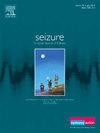Loss-of-function variant in KCNH3 is associated with global developmental delay, autistic behavior, insomnia, and nocturnal seizures
IF 2.7
3区 医学
Q2 CLINICAL NEUROLOGY
引用次数: 0
Abstract
Introduction
The KCNH gene family encodes voltage-gated potassium (Kv) channels of the EAG subtype covering three subfamilies (Kv10–12). EAG channels are involved in the control of cardiac and neuronal excitation, and pathogenic variants in KCNH genes encoding Kv10 (eag) and Kv11 (erg) subfamily members cause a broad clinical spectrum ranging from cardiac arrhythmia to neurodevelopmental syndromes. However, no pathogenic variants have been hitherto reported for KCNH genes encoding Kv12 (elk) subfamily members.
Methods
Clinical, genomic, and functional studies were performed, including voltage-clamp experiments using heterologous channel expression in Xenopus oocytes.
Results
We examined an eight-year-old girl presenting with global developmental delay, intellectual disability, autistic and aggressive behavior, hyperactivity, insomnia, and nocturnal seizures. Focal seizures were successfully treated with sulthiame, which reduced the occurrence of temporo-parietal spike-wave paroxysms. Trio exome sequencing revealed a heterozygous de novo missense variant, NM_012284.3:c.1112C>T; p.(Ala371Val), in KCNH3, which encodes the Kv channel α-subunit Kv12.2. The amino acid substitution associated with the KCNH3 variant identified in the patient is located at a site highly conserved in EAG channels. The analogous variant in KCNH2 causes long-QT-syndrome 2, and has also been associated with epilepsy. Electrophysiological characterization of the KCNH3 p.(Ala371Val) variant demonstrated loss-of-function of the mutant Kv12.2 channels and strongly reduced current amplitudes upon co-expression of wildtype and mutant channel subunits in a dominant-negative manner.
Conclusion
Our results propose KCNH3, which is primarily expressed in the nervous system, as a new disease gene associated with a neurodevelopmental phenotype including seizures.
KCNH3的功能丧失变体与整体发育迟缓、自闭症行为、失眠和夜间癫痫发作有关
KCNH基因家族编码EAG亚型的电压门控钾(Kv)通道,涵盖三个亚家族(Kv10-12)。EAG通道参与心脏和神经元兴奋的控制,编码Kv10 (EAG)和Kv11 (erg)亚家族成员的KCNH基因的致病变异引起从心律失常到神经发育综合征的广泛临床谱。然而,迄今为止还没有报道编码Kv12(麋鹿)亚家族成员的KCNH基因的致病变异。方法利用异种通道在非洲爪蟾卵母细胞中的表达进行临床、基因组和功能研究,包括电压钳实验。结果我们检查了一名8岁女孩,表现为整体发育迟缓、智力残疾、自闭症和攻击行为、多动、失眠和夜间癫痫发作。磺胺成功地治疗了局灶性癫痫发作,减少了颞顶尖波发作的发生。三重奏外显子组测序显示一个杂合的新生错义变异,NM_012284.3:c.1112C>;T;p.(Ala371Val),在KCNH3中编码Kv通道α-亚基Kv12.2。在患者中发现的与KCNH3变异相关的氨基酸取代位于EAG通道中高度保守的位点。KCNH2的类似变异导致长qt综合征2,也与癫痫有关。kcnh3p (Ala371Val)变异的电生理特征表明突变型Kv12.2通道的功能丧失,并且在野生型和突变型通道亚基以显性负性方式共同表达时,电流振幅强烈降低。结论KCNH3主要表达于神经系统,是一种与癫痫等神经发育表型相关的新疾病基因。
本文章由计算机程序翻译,如有差异,请以英文原文为准。
求助全文
约1分钟内获得全文
求助全文
来源期刊

Seizure-European Journal of Epilepsy
医学-临床神经学
CiteScore
5.60
自引率
6.70%
发文量
231
审稿时长
34 days
期刊介绍:
Seizure - European Journal of Epilepsy is an international journal owned by Epilepsy Action (the largest member led epilepsy organisation in the UK). It provides a forum for papers on all topics related to epilepsy and seizure disorders.
 求助内容:
求助内容: 应助结果提醒方式:
应助结果提醒方式:


